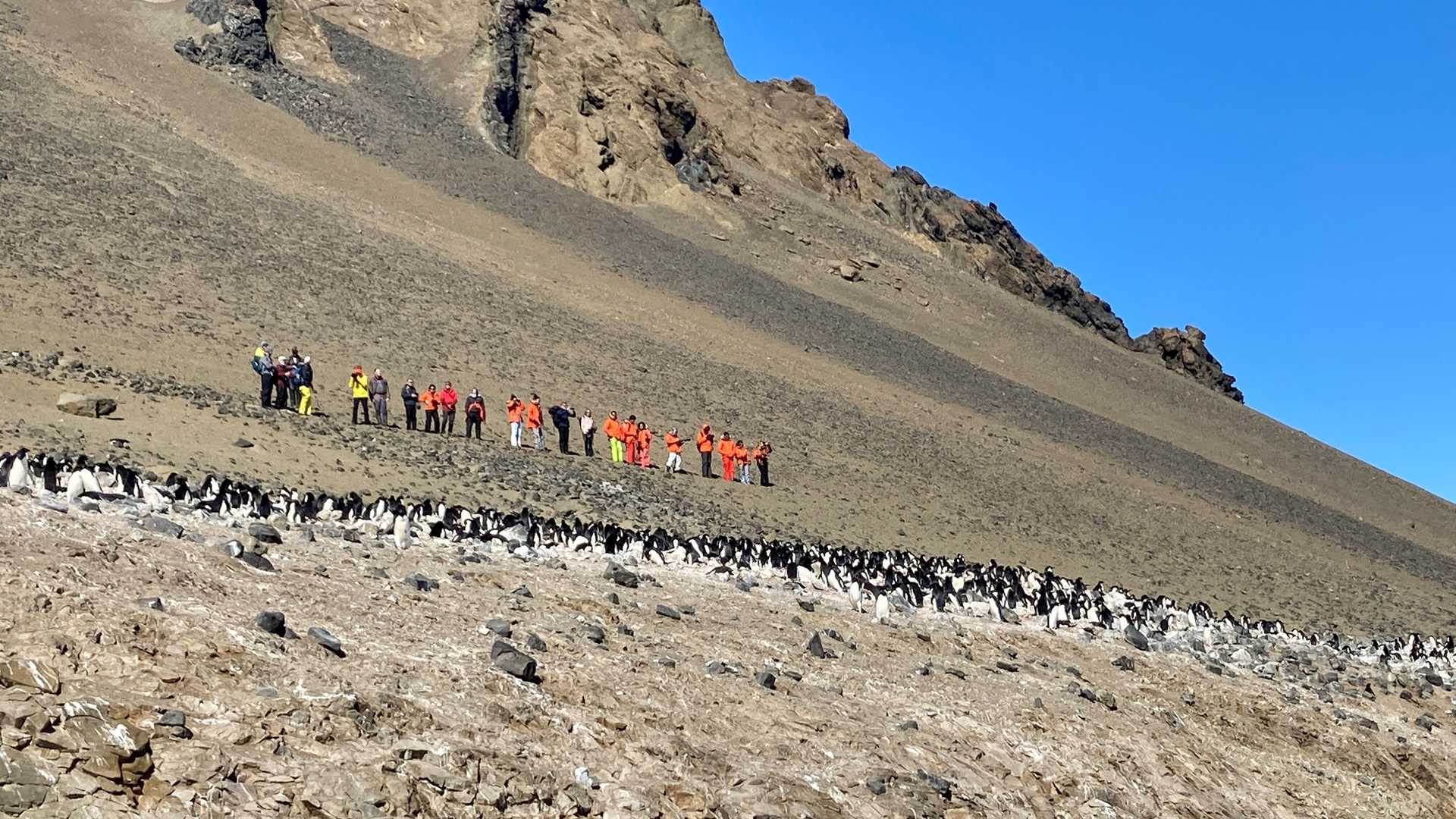This morning, we were woken up at 5:00 a.m. Over the intercom, our expedition leader’s calm voice let us know that over thirty killer whales were surfacing around the boat. Weary-eyed and full of wonder, we all watched in the absolute stillness of the morning as over five groups of killer whales hunted and frolicked around the bay. Some chased penguins, and others seemed to be enjoying family time with their youngsters. After breakfast, we went ashore on Devil Island to enjoy an Adelie penguin colony amidst the bergs. Some of us hiked up the ridgeline, and some of us stayed along the beach. We were all treated to lots of calving icebergs as the tide continued to lower throughout our morning operations. In the afternoon, we set foot on the peninsula proper and explored Bald Head. Many Weddell seals and gentoo penguins frolicked on the beach while we hiked over the hill to the overlook. Along the hike, we found two mummified seal carcasses and stopped to admire their amazing teeth, which have adapted for eating krill.
- Daily Expedition Reports
- 23 Dec 2022
The Weddell Sea, 12/23/2022, National Geographic Resolution
- Aboard the National Geographic Resolution
- Patagonia
Katie Mills-Orcutt, Undersea Specialist
Katie Mo started her career as a naturalist on Catalina Island where she taught marine science outdoor education and SCUBA diving. Her passion for conservation biology then led her to pursue a Masters degree in marine science at Western Washington Un...
Read MoreShare Report
Patagonia: Chilean Fjords and Argentina's Staten Island
VIEW ITINERARYRelated Reports
10/29/2024
Read
National Geographic Explorer
Staten Island (Isla de los Estados)
We left the Beagle Channel in the middle of the night to cross from Tierra del Fuego to the rarely visited Staten Island. Less than 1,000 people visit this island which is frequently referred to as ‘the end of the Americas.’ At the mouth of Franklin Bay on the northwest of Staten Island, we spent time among thousands of rockhopper penguins. Across the entire island, there are an estimated 130,000 breeding pairs of rockhoppers on the island, making the total population over half a million individuals! Several species of seabirds took advantage of the brisk winds around us and we had our first look of the striated caracara, one of the rarest in the group. We have many naturalists and guests on this trip who are passionate about birds of prey, so we enjoyed watching their skillful soaring overhead. In the afternoon, the weather cooperated nicely which allowed us to Zodiac to shore for a wet landing. Once ashore, we removed our life vests, donned our packs, and trekked along the ridge above Elgor Bay. The reward at the end of the trail was a historic lighthouse considered to be the southernmost lighthouse on the continent. This lighthouse inspired the adventure novel, The Lighthouse at the End of the World by Jules Verne, a tale which includes pirates and survival in one of the harshest environments in the world.
10/28/2024
Read
National Geographic Explorer
Garibaldi Glacier and the Beagle Channel
Although offshore waters were windy, we found nice protection in Garibaldi Fjord, a long and beautiful glacial cut into the Cordillera Darwin. The towering cliffs were lined with waterfalls, and southern sea lions were hauled out on shore. We took to the Zodiacs and spent the morning weaving through brash ice and watching imperial cormorants prepare their nests. The Garibaldi Glacier did not disappoint! The cloudy and drizzly day enriched the deep blues of the glacier itself. Small calvings (bits of falling ice) kept our interest during our visit. Then, just as we needed to move on, the glacier showed signs of a larger spectacle, and BOOM! Towers of ice the size of buildings came crashing down at once, much to the delight of all. Finally, our Naturalists Shel, Isai, and Ezra enlightened us with tales of Patagonia.







